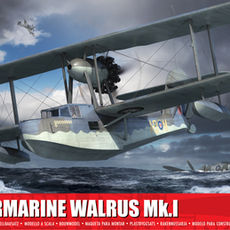Military Model Scene
Robin Buckland's
Airfix re-releases April 2024
...3 popular kits return to the catalogue

Airfix Re-Releases April 2024
News of the return of 3 kits to the catalogue -
1/72 - Supermarine Swift FR.5
Introducing the Supermarine Swift FR.5, now making a triumphant return to the Airfix lineup!
Flying in at a skill level 2, the 1:72 scale Supermarine Swift FR.5 is brought back to life within the Airfix range, resurrected for those who missed its first debut in 2015. The kit includes the 2 original schemes from the 2015 release; both featuring RAF schemes from 1956. Once built, the Supermarine Swift FR.5 measures a total wingspan of 138mm and 180mm in length and contains 62 parts.
The Supermarine Swift was originally designed as an interceptor fighter but was most successful as a
low-level photo reconnaissance aircraft, operating over Germany during the late 1950s. A strong airframe with good speed at low level, it excelled in this role, often beating NATO contemporaries in photo reconnaissance competitions.
The Swift still holds the honour of being the first swept-wing jet fighter in RAF service. The FR.5
proved itself in the reconnaissance role, winning the NATO 'Royal Flush' reconnaissance competition in 1957 and 1959, conclusively beating off the best types of other nations could offer.
Scheme A: Supermarine Swift FR.5, Flown by Flight Lieutenant Nigel Walpole, No.79 Squadron,
Royal Air Force Germany, Gütersloh, Germany, April 1956.
Scheme B: Supermarine Swift FR.5, No. II (AC) Squadron, Royal Air Force Germany, Jever,
Germany, 1956.
1/48 - Supermarine Walrus Mk.1
Ranked at skill level 3, the 1:48 scale Supermarine Walrus Mk.I makes a comeback to the Airfix lineup after its first release in 2017. This revived kit stays true to its roots, presenting builders with three unique schemes featuring liveries from: The Royal Air Force, Naval Air Force, and the Royal Australian Air Force. Upon completion, the Supermarine Walrus Mk.I boasts a wingspan of 292mm and a length of 238mm and consists of 157 parts.
Despite its rather ungainly appearance, the Supermarine Walrus was one of the most effective aircraft of its type ever built. Required to operate in particularly hostile environments, the Walrus was an excellent naval reconnaissance aircraft and became an invaluable air-sea rescue asset, responsible for saving the lives of many downed airmen.
First developed to a Royal Australian Air Force requirement for a catapult launched reconnaissance amphibious flying boat, the Walrus gained fame and respect not only for its usefulness but also its toughness. Despite its fragile appearance, the Walrus was tremendously strong and able to withstand both the forces of a catapult launch as well as landing and taxiing on often rough North Atlantic and Pacific oceans. Its original role was one of spotting for the fleet, Walruses being used in many of the early sea battles of the Second World War. As the war raged on the Walrus was later to be found patrolling the skies over the English Channel, rescuing downed pilots from both sides, and saving thousands of lives in the process.
Scheme A: Supermarine Walrus Mk.I, No. 276 Squadron, Royal Air Force Harrowbeer, Devon,
England, 1944.
Scheme B: Supermarine Walrus Mk.I, No. 700 Naval Air Squadron, HMS Sheffield, 1941.
Scheme C: Supermarine Walrus Mk.I, No. 5 CF Royal Australian Air Force, Australia and New
Guinea, early 1943.
1/72 - Armstrong Whitworth Whitley Mk. V
Landing at a skill level 3, the 1:72 scale Armstrong Whitworth Whitley Mk.V has returned to reignite its legacy, having originally launched in 2015. This kit faithfully represents its counterpart, with two authentic RAF schemes from Bomber Command dating back to 1940/1. Once built, the Armstrong Whitworth Whitley Mk.V measures a total wingspan of 356mm and 313mm in length and contains 152 parts.
The Armstrong Whitworth Whitley was one of the three twin engine RAF medium bombers in service at the outbreak of the Second World War. Despite its low speed, poor service ceiling and small bomb load the Whitley was an important type for the RAF in this period, forming the backbone of the early night bombing offensive. Later in the war it was used both by Coastal Command and as a glider tug.
Scheme A: Armstrong Whitworth Whitley Mk.V, Aircraft flown by Squadron Leader Charles
MacDonald, No. 102 Squadron, No. 4 Group (Bomber Command), Royal Air Force Driffield,
Yorkshire, England, March 1940.
Scheme B: Armstrong Whitworth Whitley Mk.V, No. 10 Squadron, No. 4 Group (Bomber
Command), Royal Air Force Leeming, Yorkshire, England, December 1941.
Thanks to Airfix for the news
Robin














